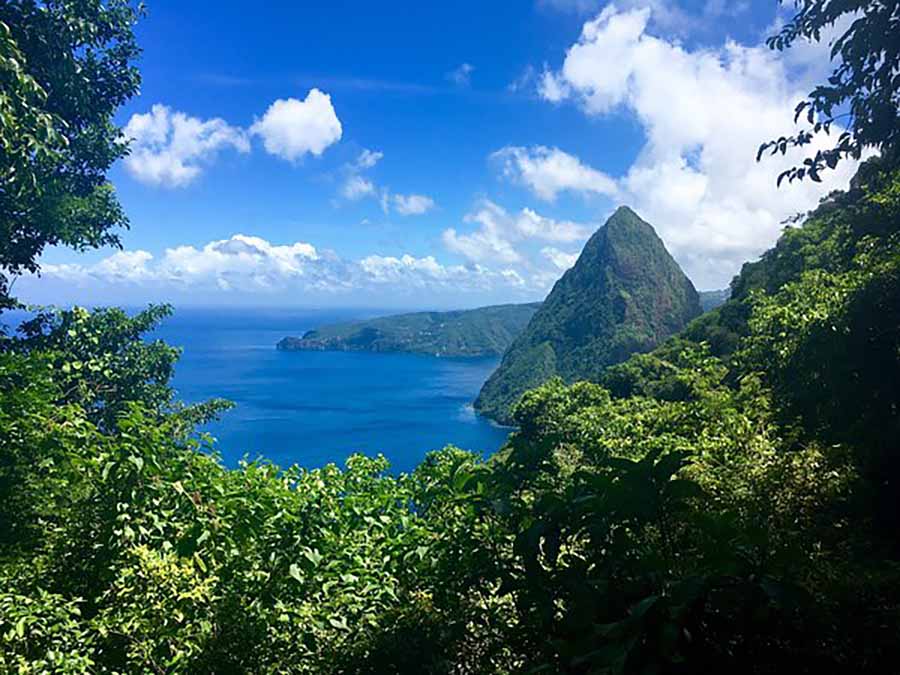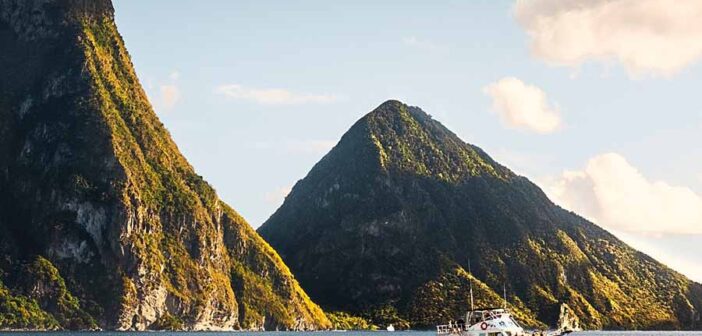
The spirit of Saint Lucia is captured in the vibrant melodies and evocative stories that reflect its lush landscapes and resilient Caribbean soul. A poignant quote comes from the national anthem, “Sons and Daughters of Saint Lucia,” written by Charles Jesse in 1967, with the line, “Sons and daughters of Saint Lucia, love the land that gave us birth.” This lyric embodies the deep pride and connection the Lucian people feel for their island nation.
In poetry, the Saint Lucian poet Derek Walcott, Nobel Laureate, in his collection Omeros (1990), writes, “The Pitons rise where our hearts root in Gros Islet’s sand.” This reference to the iconic Piton mountains and the vibrant Gros Islet community ties Saint Lucia’s identity to its dramatic natural beauty and cultural vitality.
A local reference in a television show appears in Death in Paradise (2011–present), set in the fictional Saint Marie but filmed in Saint Lucia, where a character says, “Soufrière’s sulphur springs breathe our island’s fire.” This nod to Soufrière and its volcanic springs captures Saint Lucia’s dynamic spirit and geothermal allure.
These examples from song, poetry, and television weave together Saint Lucia’s essence—its natural splendour, cultural richness, and enduring pride—celebrating an island that thrives through its art and heritage.
Natural Beauty and Adventure:
Saint Lucia, a lush island in the Eastern Caribbean’s Lesser Antilles, is a tropical paradise renowned for its dramatic Piton mountains, pristine beaches, vibrant Creole culture, and romantic allure. Often called the “Helen of the West” for its beauty and history of French-English rivalry, it offers a mix of adventure, relaxation, and cultural immersion. In 2025, Saint Lucia expects over 400,000 visitors, building on 2024’s record arrivals, with new luxury resorts, sustainable tourism initiatives, and an expanded Carnival.
- The Pitons: These UNESCO World Heritage volcanic peaks—Gros Piton (2,619 ft, 3-hour guided hike) and Petit Piton (4-hour, more challenging)—offer breathtaking views of the ocean and jungle. Gros Piton’s trails are well-managed, rewarding hikers with sights of Saint Vincent Island.
- Beaches: Sugar Beach, Located between the Pitons, boasts golden sands and iconic views. Anse Chastanet is a snorkeling haven with vibrant reefs. Rodney Bay’s Reduit Beach is lively, with water sports, while quieter Marigot Bay, a historic English hideout, offers palm-lined shores and clear waters. Pigeon Island National Park features two beaches and 360° northwest coast views.
- Sulphur Springs: The world’s only drive-in volcano near Soufrière offers therapeutic mud baths and hot springs, said to benefit skin health. Nearby waterfalls, like those at Diamond Botanical Gardens, provide refreshing rinses.
- Rainforests and Wildlife: The Main Ridge Forest Reserve and Des Cartier Rainforest Trail are ideal for hiking past guava trees and spotting the rare St. Lucia parrot. The Millet Bird Sanctuary and Bois D’Orange Swamp attract birdwatchers with species like the white-breasted thrasher. Whale and dolphin watching peaks from October to February. Ziplining at Rainforest Adventures, bamboo rafting on the Roseau River, kitesurfing, and scuba diving in coral-rich waters. Open-air tram rides explore the rainforest canopy, while ATVs tackle countryside trails.
Cultural and Historical Sites:
- Castries: The capital, founded in 1650, features Fort Charlotte (18th-century) and La Toc Battery for panoramic views, plus the 19th-century Saint-Etienne Cathedral. Morne Fortune (Hill of Good Luck) overlooks La Toc Beach.
- Soufrière: This historic town near old plantation estates like Fond Doux offers insights into colonial history. The Folk Research Centre showcases Kwéyòl (French Creole) culture.
- Pigeon Island National Park: A 44-acre site with Carib and pirate history, featuring 18th-century English Fort Rodney ruins and trails.
- Cultural Experiences: Friday-night fish fries in Gros Islet or Anse La Raye are lively street parties with local food, music, and dancing. Visit cocoa plantations to learn chocolate-making or explore archaeological sites in Vieux Fort.
- Cuisine: Saint Lucia’s food blends Creole, French, African, and English influences. Try callaloo soup (national dish), saltfish with green figs, or fresh seafood like conch and mahi-mahi. Restaurants like The Coal Pot (Castries) offer waterfront dining, while Roots Beach Bar in Marigot Bay serves casual barbecue.
Festivals and Events:
- Saint Lucia Carnival (July): A cultural highlight with J’ouvert (4 a.m. paint and powder street party), the Parade of the Bands (July), and competitions like Soca Monarch and Calypso. Expect vibrant costumes, soca music, and fetes like Colour Me Red on Pigeon Island. It drew 18,000 visitors in 2024.
- Saint Lucia Jazz & Arts Festival (April–May): Features global artists in afrobeat, jazz, reggae, and more, set against iconic backdrops.
- Friday Fish Fries: Weekly communal events in fishing villages, blending food, music, and local vibes.
Practicalities:
- No visa is required for Ireland and the EU, US,Canadian, or most European citizens; a passport valid for the stay’s duration and a return ticket suffice. Complete the online immigration form 72 hours before arrival (stlucia.org/entry).
- Hewanorra International Airport (UVF) in Vieux Fort or George Charles Airport (SLU) in Castries serve flights from the US (4 hours, $300–600 USD round-trip) and England (9 hours). Cruise ships and ferries dock at Port Castries or Soufrière.
- Currency: Eastern Caribbean Dollar (XCD, ~2.7 XCD = 1 USD). US dollars are often accepted; credit cards work in cities, but cash is needed for minibuses and markets.
- Language: English is official, but 95pc speak Kwéyòl (French Creole). Tourism staff use English, though place names reflect French roots. A Level 1 US Travel Advisory (Exercise Normal Precautions) notes low but present crime, including petty theft and rare robberies. Avoid isolated beaches, Morne du Don in Castries, Wilton’s Yard, Chaussee Road, and Anse La Raye waterfalls at night. Sexual assault and armed robbery are uncommon but reported. Use taxis after dark, secure valuables, and avoid driving at night in rural areas due to poor roads. Hurricane season (June–November) brings rain and rare storms; monitor forecasts. Register with the US STEP program. Emergency: 911.
- Health: No mandatory vaccines, but hepatitis A, typhoid, and yellow fever (if from endemic areas) are recommended. Dengue and Zika risks require DEET repellent. Tap water is safe but chemically treated; bottled water is preferred. Medical facilities (Victoria Hospital, St. Jude’s, Tapion) are limited; evacuation to Miami or Martinique may be needed for serious cases. Ensure insurance covers this.
- Transportation: Rent a car (~$70/day) for flexibility, but drive on the left and beware potholes and twisty roads. Minibuses connect Castries, Vieux Fort, and Soufrière but are crowded. Water taxis link Rodney Bay, Marigot Bay, and Soufrière. Taxis (e.g., Saint Lucia Taxi Service) are reliable; agree on fares upfront. Helicopter transfers are available.
- Cultural Etiquette: Dress modestly in towns (no swimwear). Greet locals politely. During Ramadan (February 28–March 30, 2025), respect fasting. Tipping is often included (10pc); additional tips are optional.
- LGBTQ+ Considerations: Same-sex acts are illegal, though rarely enforced. Public displays of affection (same-sex or heterosexual) are uncommon due to conservative attitudes. Discretion is advised.
- Power: 240V, 50Hz, with Irish-style three-pin plugs. Bring a converter for US devices.
Best Time to Visit:
- Dry Season (December–May): Ideal for beach days and hiking, with 72–85°F temperatures, minimal rain (February–March are driest), and vibrant festivals. Peak season (mid-December–March) sees crowds and higher prices (~$200–500/night). Book early.
- Shoulder Season (April–June): Warm (73–88°F), affordable, and less crowded, with good swimming conditions (82°F water in April–May).
- Wet Season (June–November): Hot (75–88°F), humid, and rainy, with September–October as the wettest and hurricane-prone months. Rates drop 20–40pc, but some attractions may close.
What’s New in Saint Lucia
- Record Arrivals: Saint Lucia expects to surpass 2024’s 400,000+ visitors, with plans for 1,000 new hotel rooms by 2025 to accommodate growth. The Saint Lucia Tourism Authority’s community-focused agency, launched in May 2025, supports local entrepreneurs, enhancing authentic experiences.
- New Resort: Secrets St. Lucia Resort & Spa, an adults-only, all-inclusive property, opened in June 2025 near Rodney Bay. It features 355 rooms, nine restaurants, seven bars, three pools, and a spa, just 15 minutes from Castries.
- Transportation Upgrades: Eco-friendly water taxis expand sustainable travel options along the west coast. Improved roads and helicopter transfers enhance accessibility, particularly to the south.
Sustainable and Cultural Tourism:
- Sustainable Agriculture Tours: New tours explore organic farms growing bananas, cocoa, and spices, offering hands-on planting and harvesting. These emphasize local support and award-winning chocolate production.
- Wellness Retreats: Sol Sanctum, a family-owned boutique wellness resort, gains traction with tai chi, yoga, and sound healing amidst lush landscapes.
- Cultural Immersion: The community tourism agency promotes Kwéyòl experiences, like cooking classes and village visits, fostering deeper connections with locals.
Challenges:
- Crime: While generally safe, petty theft and rare violent crimes (robbery, sexual assault) occur, particularly in Castries and isolated areas. Avoid non-tourist zones like Wilton’s Yard and night travel in the south.
- Hurricane Season: June–November brings rain and low storm risk, but Saint Lucians believe the island is divinely protected. Monitor forecasts if visiting in September–October.
- LGBTQ+ Concerns: Conservative attitudes and laws against same-sex acts (rarely enforced) require discretion for LGBTQ+ travelers.
Practical Tips for Visitors
- Planning: Book accommodations and tours early for December–May, especially for Carnival or Jazz Festival. Use stlucia.org or operators like Serenity Tours for tailored itineraries. Check entry requirements at stlucia.org/entry.
- Transportation: Rent a 4×4 (~$70/day) for rural roads; drive on the left. Use water taxis or reputable services like Saint Lucia Taxi Service. Avoid night driving. Secure valuables, use hotel safes, and stick to busy areas at night. Monitor weather during June–November. Register with STEP.
- Cultural Etiquette: Dress respectfully in towns, greet locals, and tip 10–15pc if not included. Learn Kwéyòl phrases like “bonjou” (hello).
- Health: Use DEET repellent, carry medications, and drink bottled water in rural areas. Ensure insurance covers evacuation. Complete the SATUSEHAT Health Pass.
- Packing: Bring lightweight clothing, hiking shoes, bug spray, sunscreen, and an English plug adapter (240V). Rain gear is useful for June–November.
In 2025, Saint Lucia captivates with its Pitons, turquoise beaches, and vibrant Kwéyòl culture, offering adventure, romance, and relaxation. New additions like Secrets St. Lucia Resort, an expanded Carnival, and sustainable tours elevate its appeal, aiming to surpass 400,000 visitors. While petty crime and hurricane season require caution, the dry season (December–May) promises ideal weather and festivals. Plan for Rodney Bay’s buzz or Soufrière’s serenity, embrace the island’s warmth, and dive into a Caribbean gem that’s as safe as it is stunning when navigated smartly.




